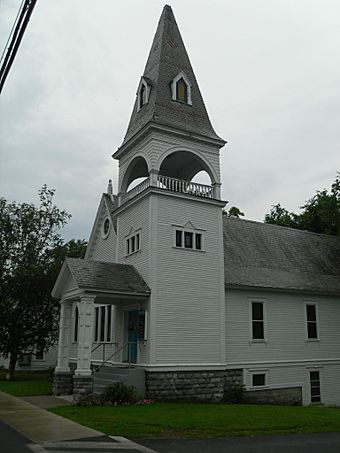Poultney Main Street Historic District facts for kids
Quick facts for kids |
|
|
Poultney Main Street Historic District
|
|
 |
|
| Location | Roughly Main St., E. Main St., Depot St., Knapp Ave., Beaman St., Grove St., Maple Ave., and College Ave., Poultney, Vermont |
|---|---|
| Area | 30 acres (12 ha) |
| Architect | Towne, William; Et al. |
| Architectural style | Late 19th And 20th Century Revivals, Greek Revival, Late Victorian |
| NRHP reference No. | 88000649 |
| Added to NRHP | June 2, 1988 |
The Poultney Main Street Historic District is a special area in the village of Poultney, Vermont. It includes the old shops, homes, and important buildings along Main Street and East Main Street. This historic district shows off many different building styles from over 100 years. It was added to the National Register of Historic Places in 1988 because of its history and unique look.
Contents
History of Poultney Village
The town of Poultney was first settled in 1771. By 1800, it had two main village centers. Poultney village, located to the west, grew to be more important. It became the main economic hub, taking over from the original town center at East Poultney.
How Main Street Grew
Main Street in Poultney was built to run from east to west. It follows a curve in the Poultney River. An important crossroads formed where Main Street met the old stagecoach route. This route connected Burlington and Albany, New York. The crossroads were at Beaman Street (Vermont Route 31) and Grove Street (Vermont Route 30).
Railroads and Industry
Poultney village became even more important for travel when the Rutland and Washington Railroad arrived. The railroad ran next to the old stagecoach route. The village also grew because of the slate quarrying industry. This industry dug up slate, a type of rock, from the ground. The slate industry was very important until the Great Depression in the 1930s. All this history helped create the many different building styles you see on Main Street today.
Exploring the Historic District
The historic district stretches along Main Street, which is a wide road. It goes from College Avenue in the west to St. Raphael's Catholic Church in the east. The district also includes buildings near the railroad tracks. These are on Depot, Church, and Knapp Streets. It also extends a short distance onto Beaman and Grove Streets.
Buildings and Styles
Most of the buildings in the district are one or two stories tall. The shops and businesses are usually two-story brick buildings. Many of them have an Italianate style, which was popular for commercial buildings. The western part of the district is mostly homes. These homes are located between the railroad tracks and the campus of Green Mountain College. The main area for shops and town buildings starts from the railroad tracks and goes east.
The buildings in the district show off many different architectural styles. Most of them are either Italianate or Colonial Revival. However, you can also find examples of Greek Revival, Queen Anne, and American Craftsman architecture. This mix of styles makes the Poultney Main Street Historic District a unique place to visit.



